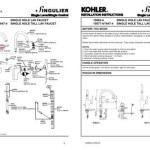How to Seal Around a Bathroom Sink
A properly sealed bathroom sink is crucial for a functional and aesthetically pleasing bathroom. It prevents water from seeping beneath the sink, causing damage to the surrounding surfaces, leading to mold growth, and potentially compromising the structural integrity of your bathroom. This article details the essential steps for effectively sealing around a bathroom sink, ensuring your bathroom remains leak-free and healthy.
1. Prepare the Area
Before starting the sealing process, it is imperative to adequately prepare the area around the bathroom sink. The following steps will ensure a smooth and successful application:
- Turn off the water supply: Locate the shut-off valve for the bathroom sink and turn it off to prevent any water flow during the project.
- Remove the faucet: It is recommended to remove the faucet for easier access to the sealing area. Unscrew the faucet nuts and carefully remove the faucet assembly.
- Clean the surfaces: Thoroughly clean the areas around the sink and the underside of the countertop with a mild detergent and a damp cloth. Ensure all dirt, debris, and residue are removed for optimal adhesion.
- Dry the surfaces: Allow the cleaned surfaces to dry completely before applying any sealant. Use a dry cloth to ensure no moisture remains.
2. Choosing the Right Sealant
Selecting the appropriate sealant for your bathroom sink is crucial. Different types of sealants are available, each with its own advantages and disadvantages:
- Silicone sealant: This is a popular choice for bathrooms due to its excellent water resistance, flexibility, and adhesion. It is also mold and mildew resistant and can withstand temperature fluctuations.
- Caulk: Caulk is another popular option for sealing around sinks. It is less expensive than silicone sealant, but it is not as durable or water-resistant. Caulk can shrink and crack over time, requiring periodic replacement.
- Epoxy sealant: This is a more durable and long-lasting sealant that is suitable for high-traffic areas. It may be more difficult to apply than silicone sealant or caulk, and it can be expensive.
- Polyurethane sealant: This sealant offers excellent adhesion and durability. It is also flexible and water-resistant, making it a suitable choice for bathroom sinks.
Consider the specific requirements of your bathroom sink when choosing a sealant. Factors to consider include the materials used for the sink and countertop, the level of moisture exposure, and the desired durability and aesthetics.
3. Applying the Sealant
Once the sealant has been chosen, it is time to apply it around the bathroom sink. Follow these steps for a successful application:
- Apply a bead of sealant: Use a sealant gun to apply a continuous, even bead of sealant along the entire perimeter of the sink where it meets the countertop. Ensure the bead is smooth and consistent.
- Smooth the sealant: Use a wet finger or a tool specifically designed for smoothing sealant to distribute the sealant evenly and remove any air bubbles. Make sure the sealant is smooth and flush with the surface.
- Allow the sealant to dry: Follow the manufacturer's instructions regarding drying time. Most sealants require at least 24 hours to cure fully. Avoid using the sink during this time to prevent disrupting the curing process.
- Clean up any excess sealant: Use a damp cloth to remove any excess sealant. Be careful not to smear the sealant that has been applied.
- Reinstall the faucet: Once the sealant has dried, reinstall the faucet assembly. Tighten the faucet nuts securely to ensure a leak-proof connection.
By carefully following these steps, you can effectively seal around your bathroom sink, preventing leaks and ensuring a long-lasting and functional bathroom.
How To Re Caulk A Bathroom Sink Ifixit Repair Guide

How To Re Caulk A Sink

Home Dzine Bathrooms How To Seal Around Bath Tub Or Basin
How To Seal A Sink Eys

How To Seal A Sink Eys

How To Seal A Sink Eys

Installing A New Bathroom Sink

How To Caulk A Bathroom Sink

How To Seal A Kitchen Or Bathroom After Tiling Walls And Floors

How To Caulk A Bathroom Sink
Related Posts







